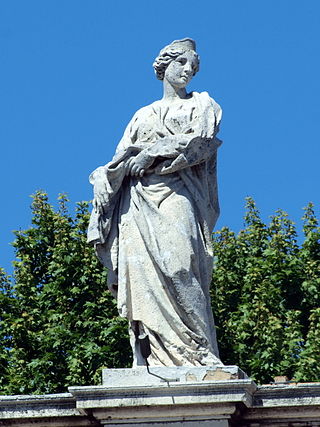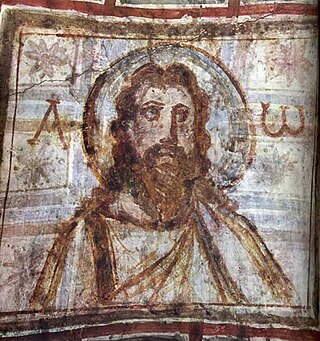Related Research Articles

The Catacombs of Rome are ancient catacombs, underground burial places in and around Rome, of which there are at least forty, some rediscovered since 1578, others even as late as the 1950s.

Nereus and Achilleus are two Roman martyr saints. In the present General Roman Calendar, revised in 1969, Nereus and Achilleus (together) are celebrated on 12 May.

The mythical Balbina of Rome, sometimes called Saint Balbina and Balbina the Virgin has been venerated as a virgin martyr and saint of the Catholic Church. As is made clear in the Catholic Encyclopaedia, it seems what follows has been nothing more than fable, not history.

The Catacomb(s) of Callixtus is one of the Catacombs of Rome on the Appian Way, most notable for containing the Crypt of the Popes, which once contained the tombs of several popes from the 2nd to 4th centuries.

The Catacomb of Generosa is a catacomb of Rome (Italy), located in Via delle Catacombe di Generosa, close to a big bight of river Tiber on the right bank, in the Portuense quarter.

The Catacomb of Saint Agnes is one of the catacombs of Rome, placed at the second mile of via Nomentana, inside the monumental complex of Sant'Agnese fuori le mura, in the Quartiere Trieste.
The Catacombs of San Valentino is one of the catacombs of Rome (Italy), placed at the 2nd mile of the via Flaminia, now in Viale Maresciallo Pilsudski, in the modern Pinciano neighborhood.

The Catacomb of San Pancrazio is a catacomb of Rome (Italy), located in the Via Aurelia, within the modern Quartiere Gianicolense.

The Catacombs of San Sebastiano are a hypogeum cemetery in Rome, Italy, rising along Via Appia Antica, in the Ardeatino Quarter. It is one of the very few Christian burial places that has always been accessible. The first of the former four floors is now almost completely destroyed.

The Catacombs of Commodilla or Catacombs of Felix and Adauctus is a three-level underground burial complex forming one of the catacombs of Rome. It is sited on via delle Sette Chiese, not very far from via Ostiense, in the Ostiense quartiere. One name derives from its founder or the donor of the land on which it was built, whilst the other its after the two main martyrs buried there, Felix and Adauctus.

The Catacomb of Santi Marco e Marcelliano is a catacomb between the ancient via Appia antica and via Ardeatina in what is now the Ardeatino district of Rome. With the catacomb of Callixtus and the Catacomb of Balbina, it is one of three catacombs in the Callixtian Complex between the via Appia antica, via Ardeatina and vicolo delle Sette Chiese.
The Catacomb of Saint Castulus is one of the catacombs of Rome, the first cemetery beyond Porta Maggiore along the ancient via Labicana. It is sited on via San Castulo near the old via Casilina, in the Tuscolano quarter. It is now in a poor condition and inaccessible.
The Catacomb of the Two Felixes is a catacomb on the ancient via Aurelia in Rome, run by the Pontifical Commission for Sacred Archaeology. Its ancient name is unknown but the Notitia ecclesiarum urbis Romae states of a catacomb near those of San Pancrazio and Santi Processo e Martiniano "and you ascend above and you will reach the church; there Saint[s] Martianus and Processus rest under the earth, and saint Lucina, virgin and martyr, in the upper part; then you will reach by the same via [Aurelia] the two martyred holy pontiffs both named Felix".
The Catacomb of Saints Processus and Martinianus is one of the catacombs of Rome. Sited on the via Aurelia, no ancient remains have been conclusively identified as being it.
The Catacomb of the Iordani is a catacomb on the left side of the ancient via Salaria in Rome, under the modern villa Ada in the Parioli quarter. It is named after the family who owned the land in which it was excavated and was badly damaged by relic-hunters and tomb-robbers before being rediscovered.

The Catacomb of Sant'Ippolito is a catacomb on the via Tiburtina in Rome, now entered from via dei Canneti in the modern Nomentano quartiere.
The Catacombs of Santa Felicita or Catacomb of Maximus is a three-level complex of catacombs on the modern via Salaria in the modern Salario quarter of Rome. In the 17th century it was also known as the Catacomb of Sant'Antonio after the patron saint of the Vienne monastery which owned the land in which it fell.
The Catacomb of San Panfilo is one of the catacombs of Rome, sited under via Paisiello and via Spontini in the Pinciano quarter and along the line of the ancient route of the via Salaria. It is named after the Carthaginian martyr Pamphilus. The modern-day entrance is in Santa Teresa del Bambin Gesù in Panfilo. The ancient sources identify it as the first catacomb on the via Salaria starting from porta Pinciana.
The Catacomb of Trasone is a catacomb on the left side of the ancient via Salaria, at its junction with via Yser, in the modern-day Parioli quarter of Rome. Begun in the 3rd century, is named after Trason or Thrason, a rich Christian Roman citizen under Diocletian and the owner of the land in which it was dug - he is named in a martyrdom account of Susanna of Rome. Ancient sources also call it Coemeterium Thrasonis ad s. Saturninum (the cemetery of Thrason at [the basilica of] saint Saturninus in memory of the main martyr buried there, the remains of whose above-ground basilica were still visible late in the 16th century.
The Catacombs of Praetextatus is a catacomb complex on the left side of the via Appia in the modern-day Appio-Latino quarter of Rome. Its modern entrance is on the via Appia Pignatelli. It is named after its founder or the man who gave the land on which it was built.
References
- ↑ (in Italian) Fiocchi-Nicolai V., Rinvenuti nei pressi del “Quo Vadis?” i resti di una Basilica paleocristiana, in L'Osservatore Romano, ed. 20 settembre 1991, p. 4
- ↑ (in Italian) Spera L., Il paesaggio suburbano di Roma dall'antichità al Medioevo, L'Erma di Bretschneider, Roma 1999, pp. 80-82
- ↑ (in Italian) De Santis L. - Biamonte G., Le catacombe di Roma, Newton & Compton Editori, Roma 1997
- ↑ (in Italian) Baruffa A., Le catacombe di S. Callisto. Storia, archeologia, fede, Libreria Editrice Vaticana, Città del Vaticano 1992, p. 164